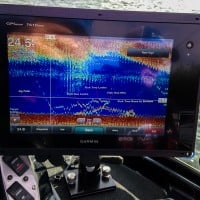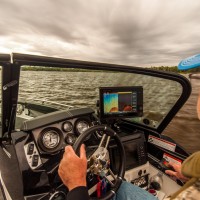I spend the last week up on LOTW with new electronics and thought I would share a little bit as there wasn’t a whole lot of intel on the interwebs prior to the purchase.
The set up is:
1 – GPSMAP 7610 XSV (10″) (console) Dash Mounted with Cisco Mount
1 – GPSMAP 840 XS – (8″) (console) Flush Mounted
1 – GPSMAP 840 XS – (8″) (bow) Flush Mounted
Transducer – GT-50 Transom Mounted
All are linked via ethernet cable.
Upgraded mapping with the Lake Vu Ultra HD
Mapping –
Initially I was nervous heading to Lake of the Woods sporting untested equipment with all of the navigation hazards but after setting up the units and looking at the maps, everything seemed to be accurate with 1ft contours. Once on the lake, the maps were very accurate, right on par with Navionics and Lakemaster. Secondly, I’ve always struggled with loading the maps on the Lowrance HDS7, as it would take too long to load while driving across the lake. The Garmin was very quick with almost zero lag time. There were only a couple instances where I’d zoom in or zoom out and it would take a second or two to load the map.
The Lake Vu Ultra HD chip offers a ton of different features, and I didn’t even get to an 1/8 of them. The only feature I used was the Auto Guidance 2.0, which essentially creates a route around islands and avoids shallow water, which you can determine. The results were mixed. For shorter, uncomplicated runs (1 to 2 miles) it would take about 20 seconds to calculate your route and it did a very good job. However, it failed when it came to longer runs. For example I wanted to go through an island rich area for about 6 miles. It took about a minute for the auto guidance progress bar to get to 97% and then it locked up on both units. Granted this is probably one of the more difficult situations you could run this in but it just flat out wouldn’t work.
Other than that problem, I would say it is just as good, and probably a bit better than Humminbird and Lowrance in terms of overall mapping performance. There also was not a noticeable difference between the XS and XSV series.
Sonar –
This is an area I was very impressed with the Garmin units. The transducer (GT50TM) I used had Chirp Technology, which a lot of the major players now use. Well worth the price for the transducer to have Chirp down, side and traditional sonar. Running the dash mounted 10″ XSV in a split screen mode with traditional and Down Vu was the way to go, as the Traditional picked up more information and you could deduct more information from but with the Down Vu you could really see bottom separation when looking for fish vs. bottom junk.
If you’re a sidescan guy, you’ll definitely like the Garmin. Incredibly crisp image, better than the bird for sure, haven’t ran the Lowrance SS enough to comment.
Interface –
This was the real seller! Wow it was a breeze to run. After an hour of using it, I felt like I’d been running the units for years. It would be no contest between Humminbird and Lowrance, as I’ve found their interfaces to be quite….dense. All the menus were straight forward and it didn’t take long to find what you were looking to find.
A few random thoughts.
The XSV’s are touch screen while the XS’s are buttons. It down poured for a few hours and the touch screen worked flawlessly. No weather proofing issues thus far.
I’m not sure if it was a set up issue, probably, but when I turned on the dash units the front would also turn on. Likewise, when I shut off the dash, the front would turn off. I’m guessing it’s a network setting as when I shut the front one off it would ask me if I want to shut down the entire system or just that specific unit.
The screen on the XSV was awesome, very crisp image and almost zero sun glare. The XS’s were definitely not as good with glare as the XSV model.
I’m sure I’ll think of some more to add, but all and all, the Garmin’s were pretty dang good. Definitely would recommend them. More reviews to come in the future.

